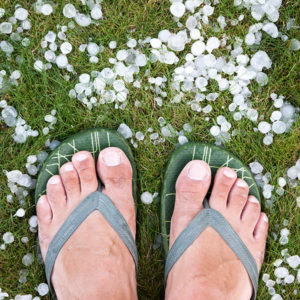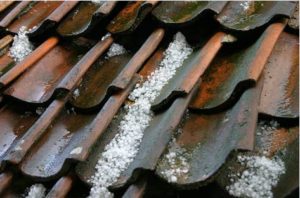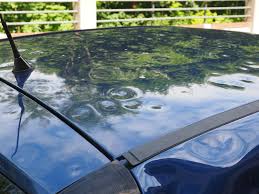When we think about major storms that have the power to destroy personal property, earthquakes, tornadoes and hurricanes come to mind. If you live in an area that is not prone to these types of natural disasters, you may even think your home and car are safe from the weather, but hail damage costs people millions of dollars each year.
What is hail? Well, it’s often confused with sleet, which actually only occurs in colder temperatures. Hail, on the other hand,  often happens during mild weather, usually in spring. Hail often happens during thunderstorms when water vapor reaches a freezing point and falls down. Hailstones can be ice pellets as small as a marble or even bigger than a baseball. As you can imagine, the larger the hail, the worse the damage to your car and home.
often happens during mild weather, usually in spring. Hail often happens during thunderstorms when water vapor reaches a freezing point and falls down. Hailstones can be ice pellets as small as a marble or even bigger than a baseball. As you can imagine, the larger the hail, the worse the damage to your car and home.
You can protect your property. Here are some ways to do it right:
Hail Proofing Your Car
On average, auto claims for hail-related damage to cars fall between $2,000 and $3,000. Hail storms happen most often in spring but they can occur during any season. The wisest thing you can do to protect your car is to park it in a covered lot. If you have a garage, you’re set. If you don’t have covered parking where you live, you should consider going to a public parking lot during a hailstorm. Here, you’ll have to sit and ride out the storm, which won’t last more than a few minutes. Until you figure out a less inconvenient solution, this is how you can prevent your car from getting dinged!
There are protective covers for sale that fold up so you can store them in your car. Some are better than others, so make sure you’re not buying something cheap that won’t withstand the assault of ice pellets. Choose a cover that is high-tech and which inflates to keep your car covered. Better yet, invest in an inexpensive carport. They come in a wide range of prices. Buy one that will withstand heavy winds, otherwise, it’s useless.
If you really want to save money but are determined to keep your car from getting wrecked, you can use thick blankets and towels. Covering your vehicle during a storm is not as easy as you’d think, however. Be careful not to ruin the car’s paint with duct tape. Without tape, however, the winds will carry your covers away. You may want to test out how you plan to secure the makeshift cover before an actual storm.
If you don’t have time to prepare and are caught in a hail storm, you should find a tall building to park next to or a gas station canopy that will shield the car from hail. Another option is to grab your floor mats and place them on your hood and roof, which are most prone to damage. Most cars these days are made with tempered-glass windows so you probably won’t have to worry as much about them. While using mats is not the most professional method of protection, it’s worth a shot and is better than nothing, even though the wind may carry them away. Just make sure to protect yourself too. You really don’t want to be outside during a hail storm.
Hail Proofing Your Home
Your home is also prone to hail damage. Hail-proofing is a very important step to ensure that your home doesn’t incur expensive damage. A good place to start is the roof, which normally bears the brunt of most storms. Having a damaged roof can cause leaks and drafts, so it’s important to keep it in good condition. Using roofing material that can withstand pellets of ice raining down on it will be important in defending your house too. Roofing material is tested for durability using steel balls of different sizes to see how well it can withstand the assault as they are dropped on its surface. The most durable and hail-resistant roofs, according to The Institute for Business & Home Safety (IBHS), are modified asphalt shingles. If you’re ready to for a new roof, this is one type you can be sure will protect your home in rough weather.
Most of us can’t just run out and get a new roof installed before the next hail storm, but what we can do is inspect what we do have to make sure it’ll still be resilient against hail causing water damage. Holes are the first things to look for and other types of damage that can be fixed easily and right away. If you’re unsure what to look for, it’s best to hire a professional. You don’t want to find out after the water damage that you only needed to shell out a fraction of the cost to fix your roof before the storm.
Skylights pose a different type of vulnerability. You’ll want to strengthen them against hail by using a strong protective screen. This is a very important step that should not be overlooked.
Windows are also very vulnerable to hail, which can chip, shatter or puncture holes in the glass. Not only will you have to replace your windows but you will also be prone to water damage, even flooding, inside your home. Ideally, you should already have impact resistant windows. If you don’t, it’s a wise investment to make.
Also, remember to bring in lawn furniture and appliances as soon as you hear of a storm brewing. Most chaises and barbecues do not fare well in hail storms.
Does Insurance Cov er Hail Damage?
er Hail Damage?
If you end up experiencing hail damage to your car, you will likely be covered if you have comprehensive insurance on your policy. If you don’t already have comprehensive protection, now may be the time to add it on, before the storms hit. Some policies have specific coverage for hail or glass damage so understand your coverage.
As for your home, the wind damage from the hail storm will be covered but any flooding resulting from the storm will only be covered if you have a separate flood insurance policy, which is not a part of a standard policy.
The information in this article was obtained from various sources. This content is offered for educational purposes only and does not represent contractual agreements, nor is it intended to replace manuals or instructions provided by the manufacturer or the advice of a qualified professional. The definitions, terms and coverage in a given policy may be different than those suggested here and such policy will be governed by the language contained therein. No warranty or appropriateness for a specific purpose is expressed or implied.

